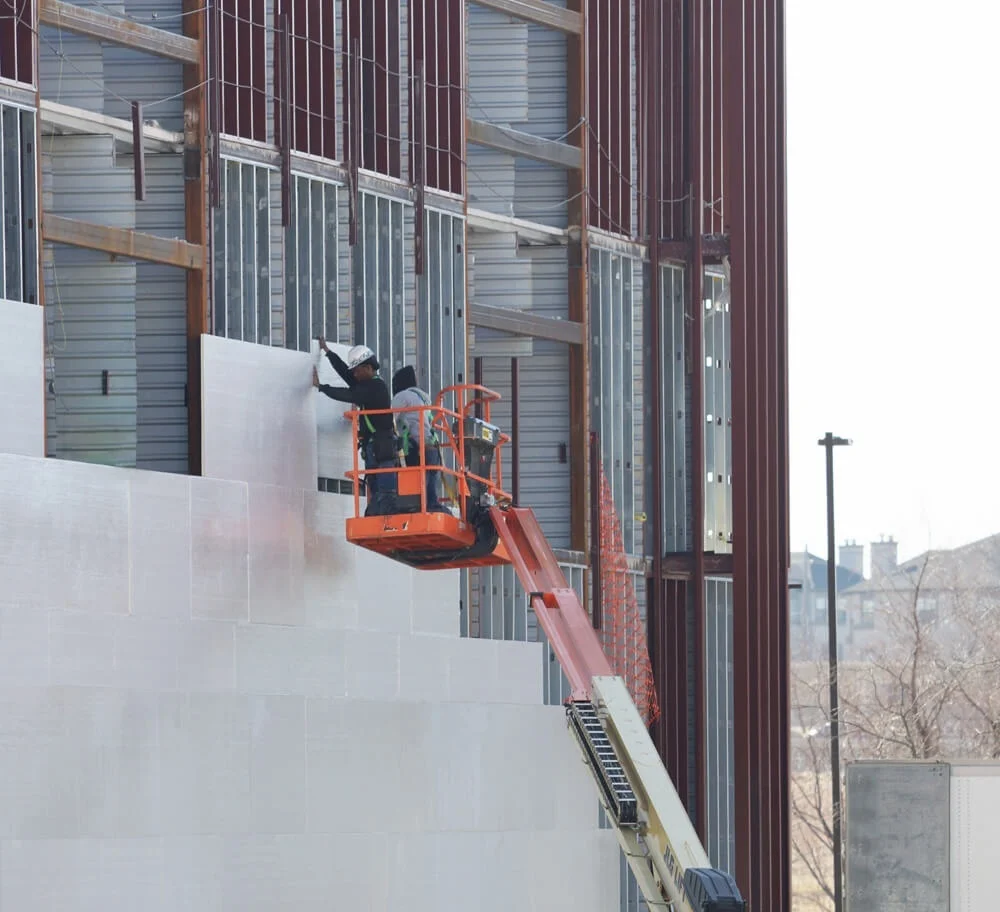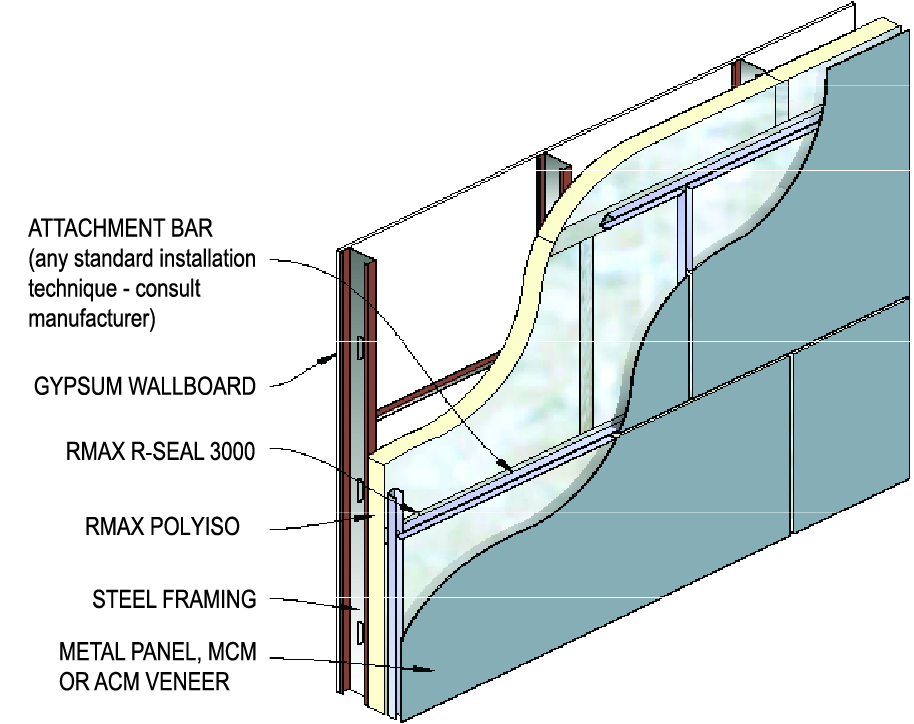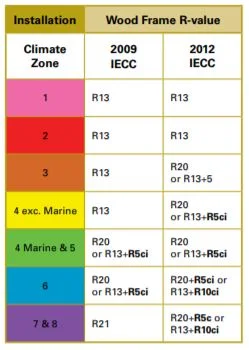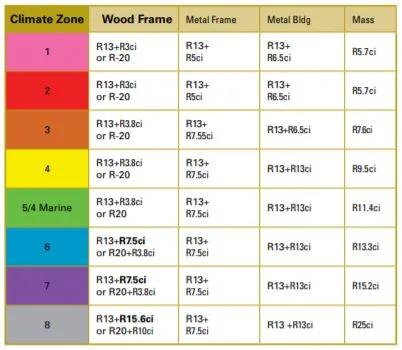Continuously Superior. Continuous Polyiso Insulation.
National model energy codes are advancing the way we approach building commercial and residential exterior walls by emphasizing the use of continuous insulation systems, which provide a continuous insulation layer over an entire wall, not just in the wall cavities. Building science experts have known for some time that continuous insulation is a very effective way to insulate building envelopes for energy savings. Now, modern building codes are putting this knowledge into practice.
what is continuous insulation
Continuous insulation is defined as “insulation that is continuous across all structural members without thermal bridges other than fasteners and service openings. It is installed on the interior, exterior, or is integral to any opaque surface of the building envelope.”*
Common Applications of Continuous Insulation:
Continuous insulation can be used with variety of wall structural systems and cladding materials such as cement board, PC stucco, wood lap, brick veneer, stone, and vinyl siding. Furthermore, continuous insulation can be placed on the interior or exterior side of the wall with proper consideration of climate-dependent moisture vapor control code requirements. For example, it is common to place continuous insulation on the inside face of foundation walls and also above-grade masonry walls, which is considered a typical practice in Florida where the exterior masonry wall face is coated with stucco or parging. Finally, it is possible to use continuous insulation alone to meet energy code without any cavity insulation for the ultimate “warm wall” design.
*ASHRAE 90.1-2007, Energy Standard for Buildings Except Low-Rise Residential Buildings, American Society of Heating, Refrigerating, and Air-Conditioning Engineers, Inc., Atlanta, GA.
What does continuous insulation do
Continuous insulation can serve several important functions in a high-performing wall system including continuous thermal insulation, moisture vapor control, water resistive barrier and air barrier.
These capabilities provide the following benefits:
Increased Thermal Performance
Continuous insulation is installed continuously over the studs providing an uninterrupted thermal barrier - eliminating heat loss, increasing the overall thermal performance of a wall assembly and a building.
Reduced Operating Costs
Continuous insulation keeps energy and heat loss to a minimum, increasing the building’s energy efficiency and leading to lower monthly operating costs.
Reduced Air Infiltration and Ex-filtration
Continuous insulation with taped or sealed joints restricts air movement through the wall, helping to further reduce building heat loss.
Reduced Risk of Water Condensation and Moisture Intrusion
Continuous insulation is a very moisture-resistant system, guarding the thermal and structural performance of the building.
Efficient Installation
When used as a multi-function sheathing, continuous insulation can simplify the steps to construct a code-compliant wall assembly.
Dimensional Stability
Polyiso insulation has excellent dimensional stability and meets ASTM C1289 Standard Specification for Faced Rigid Cellular Polyisocyanurate Thermal Insulation Board.
Why you need continuous insulation
As noted above, continuous insulation is needed to achieve high-performance wall assemblies. More importantly, it will be increasingly needed for energy code compliance (see IECC charts below) as mandated to all states that have accepted federal economic stimulus funds. As newer national, state and local energy codes continue to place a greater emphasis on energy conservation, code developers and experts are turning to a greater use of continuous insulation for its known ability to reduce thermal bridging and increase energy efficiency at reasonable first cost while providing operating cost paybacks through reduced energy bills.
Modern energy code requirements for wall insulation using continuous insulation:
2012 IECC Residential Wall R-Value
2012 IECC Commercial Wall R-Value
Figure Notes:
1. IECC = International Energy Conservation Code published by the International Code Council, Inc. Refer to ASHRAE 90.1 for alternate code-compliant wall R-values.
2. Wall R-values are shown as cavity insulation alone or as XX + X where the first number is the cavity insulation R-value and the second is for continuous insulation. Continuous insulation “ci” R-values are shown in bold.
3. The commercial Wall R-values are based on all commercial building use groups, except R (residential) which may require additional continuous insulation R-value depending on climate zone.
4. Refer to climate zone map on the next page for geographic extent of climate zones listed above.
5. If using batt insulation instead of continuous insulation, the building will require 2x6 construction.
Finally catching up…
Voluntary energy efficiency programs, such as the EPA’s EnergyStar program, have been encouraging and rewarding use of continuous insulation for some time. Model building and energy codes are finally catching up with this best practice for wall insulation.
U.S. Climate Zone Map
All of Alaska is in Zone 7 except for the following boroughs in Zone 8:
Bethel, Northwest Artic, Dellinham, Southeast Fairbanks N. Star, Wade Hampton, Nome, Yukon-Koyukuk, North Slope.
Zone 1 includes Hawaii, Guam, Puerto Rico and the Virgin Islands.
Why choose polyiso continuous insulation
Not all continuous insulation materials are equal. For example, the following two points demonstrate the superior value of polyisocyanurate insulation for continuous insulation on exterior wall assemblies:
The Highest R-value in Class
Polyiso delivers a high R-value per inch compared to other types of continuous insulation. This means more energy savings and/or more manageable wall thicknesses. Thinner, energy efficient walls using polyiso continuous insulation create more usable floor area within the footprint of the building. Also, cladding materials are more easily installed over continuous insulation products with thinner profiles like polyiso. Simply put, there’s more bang for the buck with polyisocyanurate continuous insulation wall sheathing.
Code-Compliant Wind Pressure Resistance
Foam sheathing industry testing* for code compliance at an independent laboratory has demonstrated that polyisocyanurate continuous insulation provides code-compliant wind pressure resistance for exterior wall sheathing.
Wall Moisture-Resistant Design Flexibility
Polyiso is available with a variety of facer types to provide water resistive barrier performance or to provide water vapor permeability as required by climate or code-compliant wall design preferences.
Fire Test Compliant
Polyiso, a thermoset material, stays intact during fire exposure in the ASTM E84 or “Tunnel Test.” It forms a protective char layer and remains in place during this test, thereby meeting all building code requirements and contributing to a fire-safe building. For more information on polyiso’s performance in fire tests, consult the Technical Bulletins section of polyiso.org.
While not all continuous insulation materials are equal, continuous insulation as a product class offers many advantages over other types of wall sheathing. Some of these advantages were discussed earlier. For more information on the advantages of continuous insulation over other non-continuous insulation wall sheathing choices, refer to “Overview of Wall Sheathing Options: The Value of Foam Sheathing as a Wall Covering.”*
*http://www.foamsheathing.org/ (4/17/2011)
*http://www.foamsheathing.org/tech_info/OverviewofWallSheathingOptions.pdf?PHPSESSID=5a3ak3njtrrqgtiuef6t77h0k0 (6/15/2011)
Looking for Polyiso Continuous Insulation?
Commercial
Rmax engineered products and systems allow for ultimate efficiency through multiple design options, creating ease of construction and reduced energy usage.
residential
Rmax insulation has been designed and tested to provide homes with superior insulating protection, while meeting the newest codes and requirements.
specialty
Rmax insulation products have superior performance characteristics, making them ideal for many different applications in unique market spaces.










